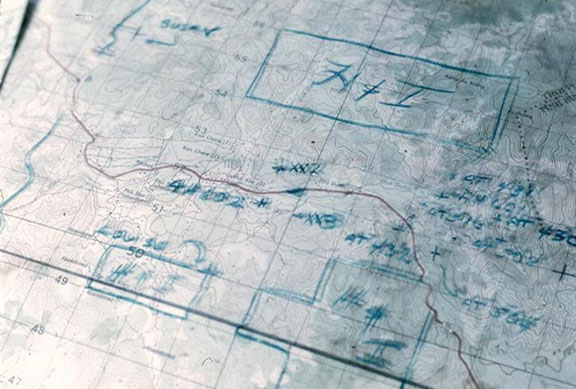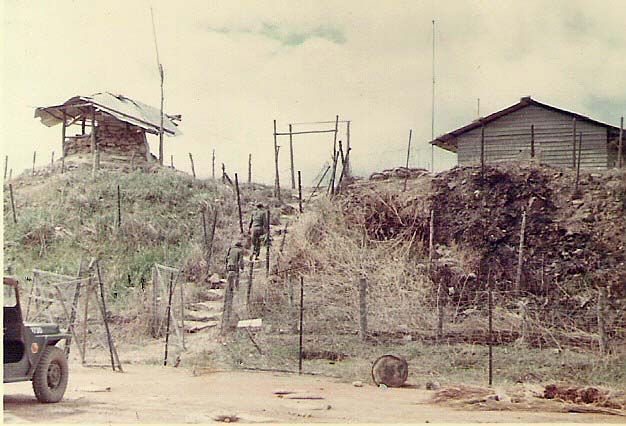
ON THE LINE

FO's Map: A/2/35 on Hwy 19, Jan67
What happens when the
enemy gets between
your troops and a civilian enclave
There was a brief mention of it in the Jan67 After Action Reports of the 35th Inf Regt. It went something like this:
6 January 1967: At 1945 hours the ARVN radio station in the Mang Giang pass (see photo below) was attacked by a force of unknown strength and sixteen mortar rounds were fired in its support
7 January 1967: At 0730 hours, vic BR216524 a Co A, 2-35 sweep discovered three fresh blood trails from counter-mortar fire. No enemy contact
Well, folks, that's not quite the way I remember it. We (A/2/35) were definitely sitting on Hwy 19 near the infamous and ever-dangerous Mang Giang (aka "Mang Yang") pass alright. And there most certainly was an ARVN radio station nearby...I had been sent to visit it several times. And the attack did occur shortly after sundown.
But that's where me and the AA report-writer part company. I guess I had better explain.
Being assigned as the FO for Capt Charlie Murray's A/2/35 was a real challenge when you're humping in the triple-canopy jungle on those "chase-your-tail" S&D missions. But, to be stationed along Hwy 19 was a little bit of a delight, job-wise. Why? Because you had actual benchmarks, landmarks, and the Highway itself to plot your position in a much more accurate manner. All that Ft Sill training ...correction..."brain-washing"... in map analysis could be put to better use than guessing where the hell you were on a map filled with "green vegetation" and an occasional stream which may or may not exist.
MY recall is that I get an urgent radio message that mortars are landing outside the A/2/35 perimeter. I grab my trusty map...made much more useful by being located near the highway...and start finding the coordinates for the incoming mortars. Much to the credit of the A/2/35 mortar platoon, they were able to respond immediately while I'm in the business of preparing a "Fire Mission" for C/2/9 which takes a tad longer. Even more to the credit of the A/2/35 mortar platoon, one of their early rounds was a "willie-peter" round that hit a hollowed tree trunk and set it on fire. Talk about a fantastic aiming point for adjusting artillery in the dark!
As you may or may not know, all the fire mission radio transmissions are monitored by the Arty LNO...in this case, it was Capt Ron Norris***. When he heard my coordinates for fire, he "got on the horn" and said: "Lieutenant, your coordinates are right between the ARVN compound and your Company's perimeter. Are you sure of the location?"
Well, gang, this is where "the rubber meets the road". You don't have time to form a committee, "ask a friend", or try out alternate courses of action. You don't have time to argue with your boss..."crunch time" has arrived and it's up to you to make a decision.
I told my boss that my coordinates indicated where the mortars were located. Much to his credit, he said "Okay, we'll fire the mission". From that day forward, Capt Norris had earned my total respect...he asked, I responded...and he went with it. Trust and respect cannot be purchased for any amount of money.
Well, it didn't take long. The rounds landed where they were supposed to (Thanks, C/2/9...Good Shooting!!) and the incoming mortars ceased immediately. Of course, it was typical of the VC to quickly set up a mortar point, fire a few rounds, and then "di-di-mau" the area. So...I won't take any special credit for the quick end of the attack. But...the story doesn't quite end here.
After getting the artillery into the "fire for effect" phase, I saw a bright and colorful after-effect...bright yellows and reds where the rounds landed. In artillery parlance, this is known as "secondary explosions". Wow! I'm on to something now! Perhaps I hit a weapons/ammunition stockpile. "Repeat FFE" I shout on the radio. Once again a beautiful afterglow of yellows and reds. Hot Dog! Let's hit 'em again! "Repeat FFE", I yell to the radio. And, once again, another afterglow of yellows and reds. Hmmm...hold on, cowboy. It's not likely that the VC/NVA had the taxpayer support to put a huge ammo depot in the middle of a war zone. It's time to quit and take a "look-see" in the morning. End of Mission.
Now I can go back "in sync" with the guy who wrote the AA report. We did go out the next morning into the impact area and we found serious blood trails. Didn't make any contact and didn't find any bodies either. But...sure enough...somebody(s) donated lots of blood out there.
Oh, yeah...my "secondary
explosions"? They're called "rocks". This particular
terrain was a rocky hillside; what I was seeing was the 105mm rounds making
impact with rocks. You have to understand that the courses at Ft Sill
didn't include being down in the impact area. All we ever saw below
"Blockhouse, Signal Mountain" was a puff of brown & grey dirty smoke when a
round landed. And you had to look quickly before it blew away in the
Oklahoma winds.
***{Capt Ronald Arthur Norris died on 9/10/13}
Lt Dennis Dauphin
Footnotes: 1. Around this time, we were getting Armed Forces radio broadcasts and some of the troops had portable radios. Just as this whole episode began, a nearby radio was playing "You've Lost That Loving Feeling". (No shit, Sherlock.)
2. According to my 3-inch reel-to-reel tape "diary" of this event, I fired a total of 235 rounds, mostly hitting the rocks. I sure got a "bang for the buck", but I don't know if the US taxpayers would agree with that!

ARVN Compound - radio relay station - Hwy 19, near Mang Yang Pass
Mang Yang Revisited
Courtesy of Sp4 Walt
Schneidereit (dec), the link above
is a historical account of this infamous pass